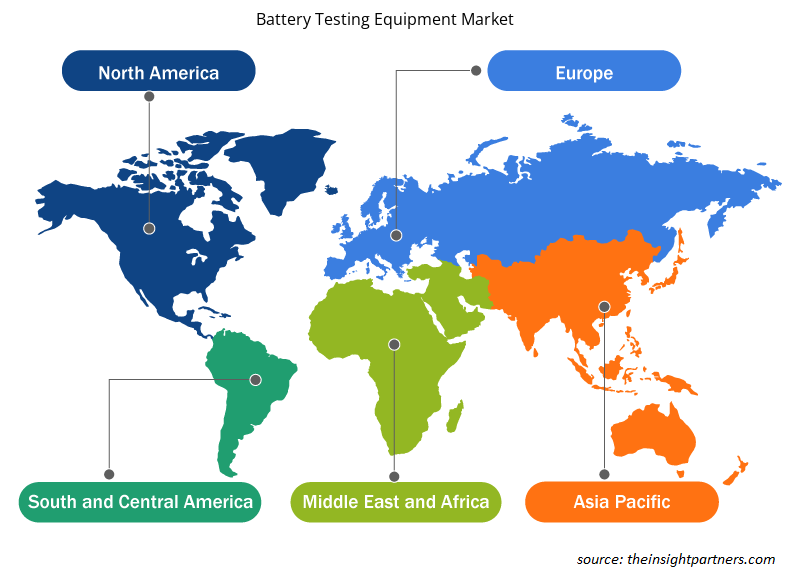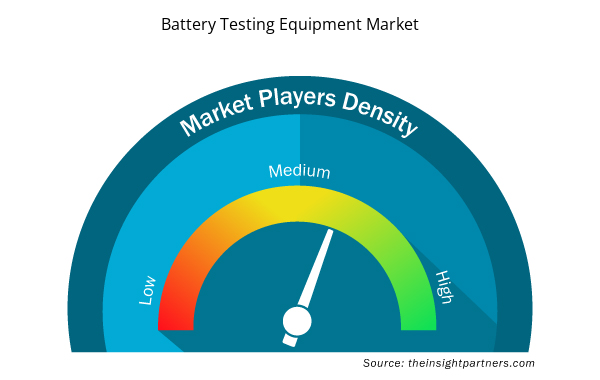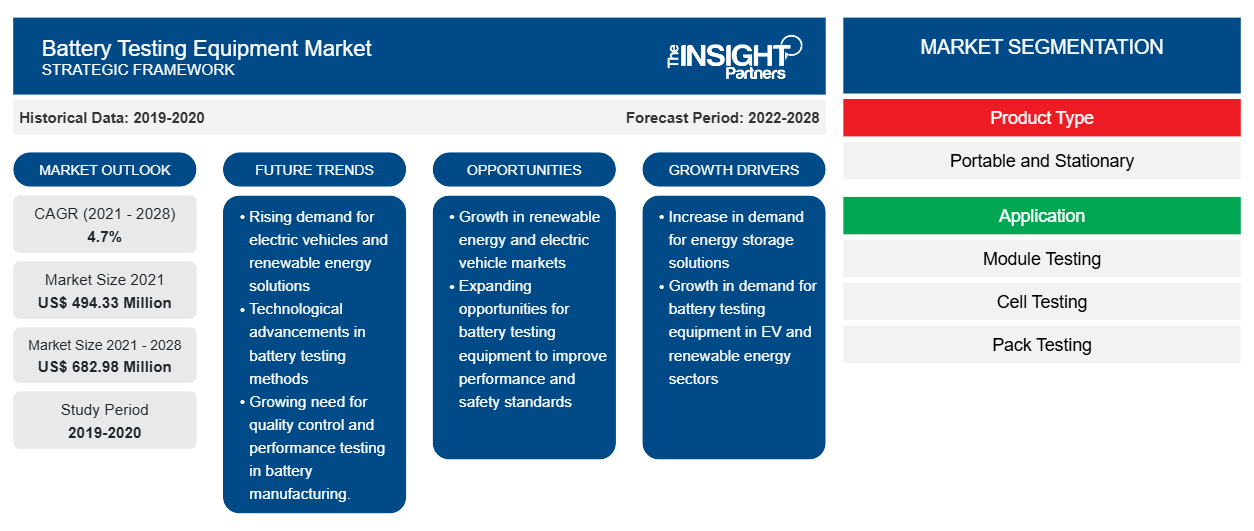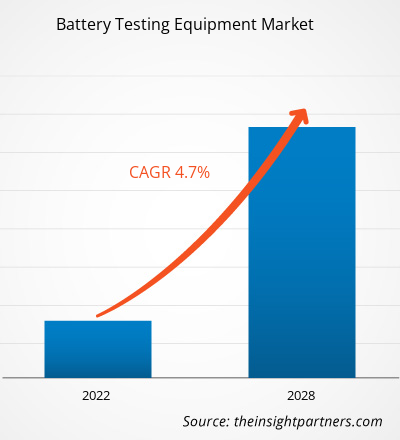Der Markt für Batterietestgeräte wurde im Jahr 2021 auf 494,33 Millionen US-Dollar geschätzt und soll bis 2028 682,98 Millionen US-Dollar erreichen; es wird mit einer durchschnittlichen jährlichen Wachstumsrate von 4,7 % zwischen 2021 und 2028 gerechnet.
Branchen wie die Luft- und Raumfahrt, Verteidigung, Automobilindustrie und das Gesundheitswesen investieren massiv in fortschrittliche Technologien, um ihre Kapazitäten mit modernen Maschinen zu stärken und ihren Kunden verbesserte Dienstleistungen anzubieten. Unternehmen in den USA, Frankreich, Schweden, Großbritannien und anderen Ländern entwickeln fortschrittliche Batterietestgeräte für ihre weltweiten Kunden. Auch die steigende Beschaffung moderner Batterien durch die US-Armee unterstützt das Marktwachstum. Darüber hinaus dürften die Entwicklung von eVTOLs und Initiativen von Regierungen in Ländern wie Deutschland, den Vereinigten Arabischen Emiraten und Singapur zur Entwicklung der Infrastruktur für urbane Luftmobilität in diesen Ländern das Wachstum der Akteure auf dem Markt für Batterietestgeräte vorantreiben.
Die Erhöhung der Verteidigungsausgaben in Ländern wie den USA, China und Indien und anderen dürfte das Wachstum des Marktes für Batterietestgeräte in den kommenden Jahren vorantreiben. Entwicklungsländer wie Indien, China und Indonesien konzentrieren sich auf die Stärkung ihrer militärischen Fähigkeiten aufgrund zunehmender grenzüberschreitender Konflikte mit Nachbarländern. Die expandierenden Fertigungssektoren in Ländern wie China und Indien treiben das Wachstum des Marktes für Batterietestgeräte weiter voran.
Passen Sie diesen Bericht Ihren Anforderungen an
Sie erhalten kostenlose Anpassungen an jedem Bericht, einschließlich Teilen dieses Berichts oder einer Analyse auf Länderebene, eines Excel-Datenpakets sowie tolle Angebote und Rabatte für Start-ups und Universitäten.
- Holen Sie sich die wichtigsten Markttrends aus diesem Bericht.Dieses KOSTENLOSE Beispiel umfasst eine Datenanalyse von Markttrends bis hin zu Schätzungen und Prognosen.
Auswirkungen der COVID-19-Pandemie auf das Wachstum des nordamerikanischen Marktes für Batterieprüfgeräte
Die USA sind das am stärksten von COVID-19 betroffene Land in Nordamerika. Viele der Produktionsstätten wurden entweder vorübergehend geschlossen oder arbeiten mit minimaler Belegschaft; die Lieferkette für Komponenten und Teile ist unterbrochen; dies sind einige der kritischen Probleme, mit denen die nordamerikanischen Hersteller konfrontiert sind.
Da es in den USA eine größere Anzahl von Batterietestgeräten, Komponentenherstellern und Industrien gibt, hat der Ausbruch jede Produktion und Umsatzgenerierung stark beeinträchtigt. Die geringere Anzahl an Produktionsmitarbeitern hat zu einer geringeren Produktionsmenge geführt. Andererseits haben sich auch die begrenzte Verfügbarkeit von Rohstoffen und die Schließung von Luft- und Raumfahrtunternehmen auf den Markt für Batterietestgeräte in den USA ausgewirkt. Die steigenden Militärausgaben des Landes und die zunehmende Entwicklung von Elektrofahrzeugen durch Unternehmen wie Tesla dürften den Akteuren auf dem Markt für Batterietestgeräte in naher Zukunft jedoch Wachstumschancen bieten.
Markteinblicke – Markt für Batterieprüfgeräte
Steigende Nachfrage nach Transportmitteln zur Förderung der
Aufgrund des steigenden verfügbaren Einkommens der Menschen in Entwicklungsländern wie China, Indien, Südkorea und anderen ist die Nachfrage nach Fahrzeugen gestiegen. Laut der Society of Indian Automobile Manufacturers (SIAM) stiegen die Pkw- Verkäufe in Indien von September 2019 bis September 2020 um 26,45 %. Faktoren wie steigende Investitionen namhafter Fahrzeughersteller und günstige staatliche Normen für den Fahrzeugbau im gesamten asiatisch-pazifischen Raum dürften das Wachstum des Marktes für Batterietestgeräte in der Region vorantreiben. Darüber hinaus dürften auch Initiativen der Regierungen von Ländern wie Vietnam zur Ausweitung ihrer Automobilindustrie das Marktwachstum für Batterietestgeräte vorantreiben.
Produkttypbasierte Einblicke
Basierend auf dem Produkttyp ist der Markt für Batterietestgeräte in tragbare Batterietestgeräte und stationäre Batterietestgeräte unterteilt. Das Segment der stationären Batterietestgeräte war mit einem Marktanteil von 54,1 % im Jahr 2020 führend auf dem Markt für Batterietestgeräte. Die stationären Batterietests werden für einen Kapazitätstest durchgeführt, wenn die Batterie im Rahmen des Abnahmetests neu ist, für Impedanztests, um Basiswerte für die Batterie festzulegen, und um den oben genannten Testprozess innerhalb von 2 Jahren für die Garantie der Batterie zu wiederholen. Der Testprozess überprüft die Impedanz vierteljährlich an ventilgeregelten Blei-Säure-Zellen (VRLA) und führt alle 25 % der erwarteten Lebensdauer Kapazitätstests durch.
Anwendungsbasierte Erkenntnisse
Basierend auf der Anwendung ist der Markt für Batterietestgeräte in Modultests, Zelltests und Packtests unterteilt. Das Segment Zelltests war im Jahr 2020 marktführend. Die Zellbelastungstests werden durchgeführt, um unter anderem die Reaktion auf elektrische, umweltbedingte und mechanische Belastungen zu bewerten. Zelltests sorgen für eine lange Batterielebensdauer und simulieren komplexe reale Testprofile. Darüber hinaus sind Zelltester für die Durchführung von Tests an Lithium-Ionen-Batterien, elektrischen Doppelschichtkondensatoren (EDLC) und Lithium-Ionen-Kondensatoren (LIC) konzipiert. Dies wird voraussichtlich den Markt für Batterietestgeräte vergrößern.
Geografisch ist der Markt für Batterietestgeräte in fünf Hauptregionen unterteilt: Nordamerika, Europa, APAC, MEA und SAM. Im Jahr 2020 hatte Nordamerika den größten Umsatzanteil, gefolgt von Europa und APAC. Der Markt in APAC wird voraussichtlich von 2020 bis 2028 mit einer CAGR von 5,8 % am schnellsten wachsen. Arbin Instruments, Century Yuasa Batteries Pty Ltd., Chauvin Arnoux, Chroma Systems Solutions, Inc., DV Power, Extech Instruments, Megger, Midtronics, Inc., Storage Battery Systems, LLC und Xiamen Tmax Battery Equipments Limited gehören zu den wichtigsten Akteuren im Ökosystem, die im Rahmen dieser Marktstudie profiliert wurden.
Regionale Einblicke in den Markt für Batterieprüfgeräte
Die regionalen Trends und Faktoren, die den Markt für Batterietestgeräte während des Prognosezeitraums beeinflussen, wurden von den Analysten von Insight Partners ausführlich erläutert. In diesem Abschnitt werden auch die Marktsegmente und die Geografie von Batterietestgeräten in Nordamerika, Europa, im asiatisch-pazifischen Raum, im Nahen Osten und Afrika sowie in Süd- und Mittelamerika erörtert.

- Erhalten Sie regionale Daten zum Markt für Batterieprüfgeräte
Umfang des Marktberichts zu Batterieprüfgeräten
| Berichtsattribut | Details |
|---|---|
| Marktgröße im Jahr 2021 | 494,33 Millionen US-Dollar |
| Marktgröße bis 2028 | 682,98 Millionen US-Dollar |
| Globale CAGR (2021 - 2028) | 4,7 % |
| Historische Daten | 2019-2020 |
| Prognosezeitraum | 2022–2028 |
| Abgedeckte Segmente | Nach Produkttyp
|
| Abgedeckte Regionen und Länder | Nordamerika
|
| Marktführer und wichtige Unternehmensprofile |
|
Marktteilnehmerdichte für Batterieprüfgeräte: Auswirkungen auf die Geschäftsdynamik verstehen
Der Markt für Batterietestgeräte wächst rasant, angetrieben durch die steigende Nachfrage der Endnutzer aufgrund von Faktoren wie sich entwickelnden Verbraucherpräferenzen, technologischen Fortschritten und einem größeren Bewusstsein für die Vorteile des Produkts. Mit steigender Nachfrage erweitern Unternehmen ihr Angebot, entwickeln Innovationen, um die Bedürfnisse der Verbraucher zu erfüllen, und nutzen neue Trends, was das Marktwachstum weiter ankurbelt.
Die Marktteilnehmerdichte bezieht sich auf die Verteilung von Firmen oder Unternehmen, die in einem bestimmten Markt oder einer bestimmten Branche tätig sind. Sie gibt an, wie viele Wettbewerber (Marktteilnehmer) in einem bestimmten Marktraum im Verhältnis zu seiner Größe oder seinem gesamten Marktwert präsent sind.
Die wichtigsten auf dem Markt für Batterieprüfgeräte tätigen Unternehmen sind:
- Arbin-Instrumente
- Chroma Systems Solutions, Inc.
- Wissenschaftliche Instrumente von Ametek
- Biologisch
- Bitrode Corporation
Haftungsausschluss : Die oben aufgeführten Unternehmen sind nicht in einer bestimmten Reihenfolge aufgeführt.

- Überblick über die wichtigsten Akteure auf dem Markt für Batterieprüfgeräte
Die Akteure auf dem Markt für Batterietestgeräte konzentrieren sich hauptsächlich auf die Entwicklung fortschrittlicher und effizienter Produkte sowie auf Kooperationen.
- Im Jahr 2021 haben Keysight Technologies, Inc. und Proventia Oy zusammengearbeitet, um Testlösungen für Batterien von Elektrofahrzeugen (EV) zu verbessern.
- Im Jahr 2021 brachte Chroma ein Schnellladetestsystem für E-Scooter auf den Markt, das der CHAdeMO Association dabei helfen soll, Ladeschnittstellenstimulatoren für Elektrofahrzeuge zu prüfen. Im Einklang mit dem internationalen Wachstum der Elektrofahrzeugbranche wird es auch dazu beitragen, das Protokollprüfblatt für Schnellladeteststandards für zweirädrige Elektrofahrzeuge zu definieren.
- Historische Analyse (2 Jahre), Basisjahr, Prognose (7 Jahre) mit CAGR
- PEST- und SWOT-Analyse
- Marktgröße Wert/Volumen – Global, Regional, Land
- Branche und Wettbewerbsumfeld
- Excel-Datensatz


- Electronic Health Record Market
- Foot Orthotic Insoles Market
- Employment Screening Services Market
- Electronic Signature Software Market
- GNSS Chip Market
- Biopharmaceutical Tubing Market
- Water Pipeline Leak Detection System Market
- Portable Power Station Market
- Embolization Devices Market
- Cell Line Development Market

Report Coverage
Revenue forecast, Company Analysis, Industry landscape, Growth factors, and Trends

Segment Covered
This text is related
to segments covered.

Regional Scope
North America, Europe, Asia Pacific, Middle East & Africa, South & Central America

Country Scope
This text is related
to country scope.
Häufig gestellte Fragen
The Animatronics is the process of manufacturing and operating lifelike robots that are used for entertainment or films; whereas, robotics is the process of designing, constructing, and operating robots. Batteries are used in these systems as they offer numerous benefits such as smooth movement of robots, enhanced safety, greater precision, and longer system life. The growing adoption of robots and animatronics in various industries, such as automobile, entertainment, manufacturing, agriculture, and aerospace and defence, it is expected to drive the growth of the battery testing equipment market.
North America is expected to hold the largest share of the battery testing equipment market in the coming years as it includes a few of the world's fastest-growing and leading economies. The North American battery testing equipment market is segmented into the US, Canada, and Mexico. High disposable incomes and technological advancements have been propelling the growth of the consumer electronics industry. With the rising integration of lithium-ion batteries in consumer electronics, the adoption of battery testing equipment will increase to analyze the battery life and leakage of the aqueous solution from the battery, among others.
The several technologically advanced solutions to maintain its global image. The global consumer goods sector is witnessing a constant rise in the adoption of advanced technologies such as smartphones, laptops, smart TVs, and smart wearable systems that are embedded with different types of batteries. With an increasing demand for the above-mentioned products, the battery testing procedure becomes crucial for enhancing the battery life, which, in turn, fuels the adoption of battery testing equipment. The stationary battery testing equipment segment led the battery testing equipment market in 2020.
The battery testing equipment market was dominated by the stationary battery testing equipment segment, which accounted to 53.7% in 2020 and is estimated to account for 51.5% market revenue share by 2028. Component providers/suppliers provide various components/parts such as fuse, powerful embedded controllers and speed fans among others hardware components to battery testing equipment manufacturers.
The battery testing equipment systems are used in various applications, including module testing, cell testing, and pack testing. Various industries such as aerospace and defence, automotive, healthcare, and others are heavily investing in advanced technologies to strengthen their capabilities with advanced machinery and offer enhanced services to customers. Companies present in countries such as the US, France, Sweden, the UK, and others are developing advanced battery testing equipment for the global market. The rising procurement of advanced batteries by the US Army is supporting the market growth.
Increasing Adoption of battery testing equipment in Healthcare, due to the ongoing COVID-19 pandemic, the demand for medical instruments, such as ventilators, diagnostic equipment, and other critical care devices, has increased across the world. Therefore, prominent battery testing equipment companies are offering continuous support and services owing to the growing demand in the healthcare industry. As these situations of battery failures in hospitals are mission-critical the batteries are discarded even when they are still usable. Therefore, continuous testing and maintenance are required to reduce battery wastage and ensure battery and equipment safety. Hence, the growing demand for medical equipment and the need to reduce battery wastage is expected to provide growth opportunities to the market.
Trends and growth analysis reports related to Electronics and Semiconductor : READ MORE..
The List of Companies - Battery Testing Equipment Market
- Arbin Instruments
- Chroma Systems Solutions, Inc.
- Ametek Scientific Instruments
- Biologic
- Bitrode Corporation
- Digatron Power Electronics GmbH
- EA Elektro-Automatik
- HEiNZINGER
- HORIBA FuelCon GmbH
- KEYSIGHT TECHNOLOGIES, INC.
- PEC
- Webasto Group
- NH Research, Inc.
- Maccor Inc.
- Unico, LLC
The Insight Partners performs research in 4 major stages: Data Collection & Secondary Research, Primary Research, Data Analysis and Data Triangulation & Final Review.
- Data Collection and Secondary Research:
As a market research and consulting firm operating from a decade, we have published and advised several client across the globe. First step for any study will start with an assessment of currently available data and insights from existing reports. Further, historical and current market information is collected from Investor Presentations, Annual Reports, SEC Filings, etc., and other information related to company’s performance and market positioning are gathered from Paid Databases (Factiva, Hoovers, and Reuters) and various other publications available in public domain.
Several associations trade associates, technical forums, institutes, societies and organization are accessed to gain technical as well as market related insights through their publications such as research papers, blogs and press releases related to the studies are referred to get cues about the market. Further, white papers, journals, magazines, and other news articles published in last 3 years are scrutinized and analyzed to understand the current market trends.
- Primary Research:
The primarily interview analysis comprise of data obtained from industry participants interview and answers to survey questions gathered by in-house primary team.
For primary research, interviews are conducted with industry experts/CEOs/Marketing Managers/VPs/Subject Matter Experts from both demand and supply side to get a 360-degree view of the market. The primary team conducts several interviews based on the complexity of the markets to understand the various market trends and dynamics which makes research more credible and precise.
A typical research interview fulfils the following functions:
- Provides first-hand information on the market size, market trends, growth trends, competitive landscape, and outlook
- Validates and strengthens in-house secondary research findings
- Develops the analysis team’s expertise and market understanding
Primary research involves email interactions and telephone interviews for each market, category, segment, and sub-segment across geographies. The participants who typically take part in such a process include, but are not limited to:
- Industry participants: VPs, business development managers, market intelligence managers and national sales managers
- Outside experts: Valuation experts, research analysts and key opinion leaders specializing in the electronics and semiconductor industry.
Below is the breakup of our primary respondents by company, designation, and region:

Once we receive the confirmation from primary research sources or primary respondents, we finalize the base year market estimation and forecast the data as per the macroeconomic and microeconomic factors assessed during data collection.
- Data Analysis:
Once data is validated through both secondary as well as primary respondents, we finalize the market estimations by hypothesis formulation and factor analysis at regional and country level.
- Macro-Economic Factor Analysis:
We analyse macroeconomic indicators such the gross domestic product (GDP), increase in the demand for goods and services across industries, technological advancement, regional economic growth, governmental policies, the influence of COVID-19, PEST analysis, and other aspects. This analysis aids in setting benchmarks for various nations/regions and approximating market splits. Additionally, the general trend of the aforementioned components aid in determining the market's development possibilities.
- Country Level Data:
Various factors that are especially aligned to the country are taken into account to determine the market size for a certain area and country, including the presence of vendors, such as headquarters and offices, the country's GDP, demand patterns, and industry growth. To comprehend the market dynamics for the nation, a number of growth variables, inhibitors, application areas, and current market trends are researched. The aforementioned elements aid in determining the country's overall market's growth potential.
- Company Profile:
The “Table of Contents” is formulated by listing and analyzing more than 25 - 30 companies operating in the market ecosystem across geographies. However, we profile only 10 companies as a standard practice in our syndicate reports. These 10 companies comprise leading, emerging, and regional players. Nonetheless, our analysis is not restricted to the 10 listed companies, we also analyze other companies present in the market to develop a holistic view and understand the prevailing trends. The “Company Profiles” section in the report covers key facts, business description, products & services, financial information, SWOT analysis, and key developments. The financial information presented is extracted from the annual reports and official documents of the publicly listed companies. Upon collecting the information for the sections of respective companies, we verify them via various primary sources and then compile the data in respective company profiles. The company level information helps us in deriving the base number as well as in forecasting the market size.
- Developing Base Number:
Aggregation of sales statistics (2020-2022) and macro-economic factor, and other secondary and primary research insights are utilized to arrive at base number and related market shares for 2022. The data gaps are identified in this step and relevant market data is analyzed, collected from paid primary interviews or databases. On finalizing the base year market size, forecasts are developed on the basis of macro-economic, industry and market growth factors and company level analysis.
- Data Triangulation and Final Review:
The market findings and base year market size calculations are validated from supply as well as demand side. Demand side validations are based on macro-economic factor analysis and benchmarks for respective regions and countries. In case of supply side validations, revenues of major companies are estimated (in case not available) based on industry benchmark, approximate number of employees, product portfolio, and primary interviews revenues are gathered. Further revenue from target product/service segment is assessed to avoid overshooting of market statistics. In case of heavy deviations between supply and demand side values, all thes steps are repeated to achieve synchronization.
We follow an iterative model, wherein we share our research findings with Subject Matter Experts (SME’s) and Key Opinion Leaders (KOLs) until consensus view of the market is not formulated – this model negates any drastic deviation in the opinions of experts. Only validated and universally acceptable research findings are quoted in our reports.
We have important check points that we use to validate our research findings – which we call – data triangulation, where we validate the information, we generate from secondary sources with primary interviews and then we re-validate with our internal data bases and Subject matter experts. This comprehensive model enables us to deliver high quality, reliable data in shortest possible time.


 Holen Sie sich ein kostenloses Muster für diesen Bericht
Holen Sie sich ein kostenloses Muster für diesen Bericht